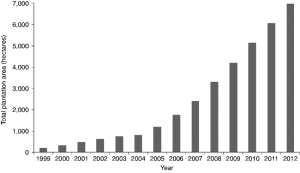
Growing Industry of Plantation
The plantation is a large scale estate that is meant for farming that specializes in cash crops. Some of the grown crops are cotton, tea, cocoa, sugar cane, oil palms, fruits, etc. For our agricultural economy plantation crops are an integral segment and are also a very significant driving factor for the growth and development of the agrarian economy of many states in India. The plantation crop sector contributes a significant amount to the foreign exchange and also the magnitude of direct and indirect employment given by the plantation sector makes it important for overall economic development. Plantations are generally done in a climate that is warm and that receive a high level of rainfall. The plantation can range in size from a few acres to thousands of acres. Plantation does require huge capital to establish the owner needs proper machinery, build roads and factories to start and package crops. There is also some additional cost included for fertilizers, pesticides, and the hired labor. The earliest plantation produced was wine and olive oil for the export of the Roman Empire. As the international trade and global economy became widely accessible the demand increased for plantation farming due to its ability to produce large quantities. Traditionally, the culture of plantation has been connected with wealth and political influence. Farmers also experimented with raising crops of rice and indigo.
Related Projects:- Plantation, Farming, Cultivation, Agro Based and Livestock Projects.
Market View Of Plantation Crops Globally

1) Coconut – Globally, coconut is grown in an area of 12.19 million ha. Asia and Pacific countries hold the major share of area and production occupying 10.7 million ha. IN recent years there has been an increase in area, production, and productivity of coconut. There have been positive trends reported in the industry of coconut and anticipated that it will grow more in upcoming years.
2) Cashew – The area that comes under cashew across the globe is 30.62 lakh ha. The production of cashew is estimated to be approx. 20.82 lakh. The share of India in the production of raw nuts is about 25%. Although in recent times India’s cashew industry is rising it is still facing stiff competition from Vietnam and Brazil in the international cashew trade. 3) Cocoa - The global production of cocoa has registered a 131.7% increase in the past 30 years and was anticipated at 3.52 million tons in the furcated period. Africa is known to be the world’s largest cocoa-producing area.
Related Books:- Herbs Cultivation, Medicinal, Aromatic Plants Cultivation, Growing, Plantation
4) Arecanut – In India, Arecanut is one of the imperative commercial crops. The industry provides nearly 10 million people of India and for most of them, it is the sole means of livelihood. India accounts for 56% of the total area and 58% of the production of areca nuts in the world.
5) Coffee – Coffee is largely consumed in the developed countries. The important produces globally are Brazil that account for 30%, Vietnam 11% and Columbia 10% and lastly Indonesia 6%. India’s coffee production is in the region of just over 4%. Arabica and Robusta coffee are the two species that are commercially cultivated in the world.
Conclusion
The book by NPCS “Detailed Project Profiles on Plantation (Agro Based Projects)” includes all the informative aspects of the plantation. The book contains information that will be helpful for all the new entrepreneurs, existing units, and technocrats. The book contains all the micro to macro components such as the introduction. Uses and applications, market survey, supplier’s addresses, plant economics, land and building, plant and machinery, etc. You can get this book from the official site of NPCS to get all the beneficial information
Tags:- #DetailedProjectReport #businessconsultant #BusinessPlan #feasibilityReport #NPCS #plantation #plantationproject #plantationbusiness #PlantationMarket #PlantationProduction